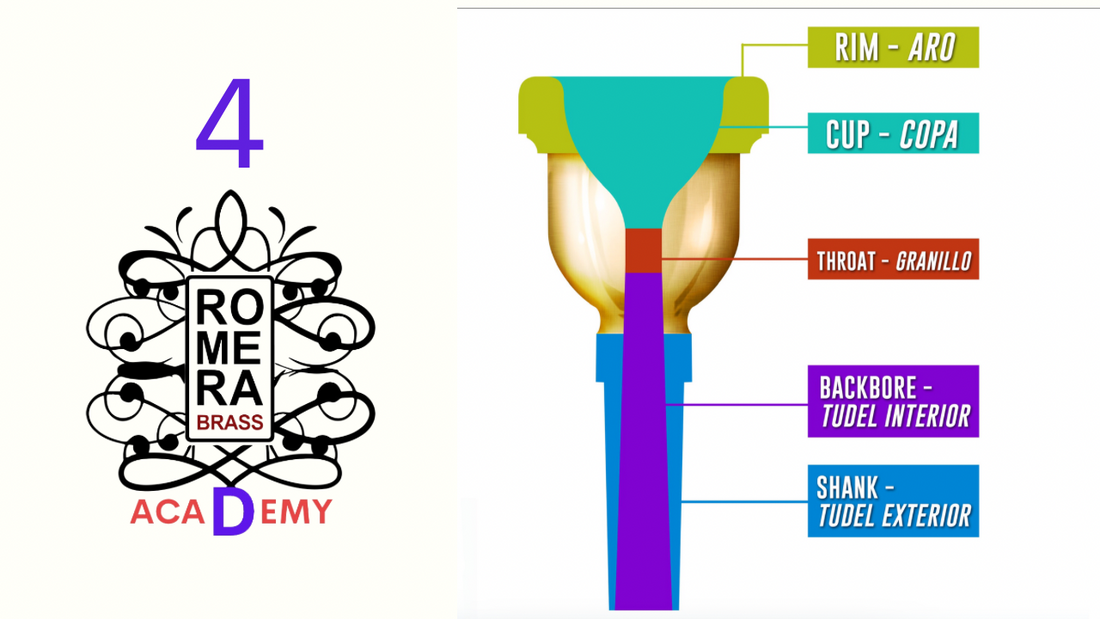
4. The parts of a mouthpiece
Share
What are the most important parts of a mouthpiece and what are they called?
Hello hello, hello, friends and friends how are you?
In this entry we are going to put the correct name to the most outstanding parts of a mouthpiece to soon dedicate new entries to talk broadly and deeply about each one of them.
To some it will seem very elementary information but we are just at the beginning of our blog And if you have students who are starting to play brass instruments, I think they might find it very interesting.
Without further ado, let's begin!
We start at the top of the mouthpiece. The set of forms that when touching has contact with the lip, is simply the attention.

The hoop is basically divided into two parts. An inner part (shape of the inside of the ring) and an outer one (outer shape of the hoop).
Where the shape of the inner and outer ring meet, an intersection point is formed which we call highlight, this particular point that is not visible to the naked eye, is where the lip has the maximum pressure on the ring.

If we look at the outside of the mouthpiece, the widest part is what we call rim outer diameter.
Inside the mouthpiece, where the inner shape of the rim ends, is where we take the measurement to know the inside diameter of a mouthpiece and we call it rim inner diameter.

When on the tab all our mouthpieces We indicate the measurement of the inner diameter of the rim (for example 16mm, 25mm, 30mm...depending on the instrument), since this measurement is exactly this point.
A little further down, we find the Cup. Its surface goes from the widest to the narrowest part of the mouthpiece.

We find cups of many shapes, tapered V-cups or more C-shaped (also called U-shaped).
The cup ends in the granillo, in the narrowest part of the mouthpiece.

The throat is the narrowest air passage in the nozzle and has two dimensions: width/granule diameter (when in the tab of all our mouthpieces we indicate the measurement of the grain diameter, for example 3.7mm, 7mm...depending on the instrument, since this measurement is exactly this point, the width of the grain) and release of the granillo (if it is shorter or longer it has a lot of influence on the control of the dive and flexibility).

On the inside of the mouthpiece, the granillo becomes more and more conical and wider. We call this part inner neck. Since it's not visible to the naked eye, it's hard to tell what shape it is, but it should be in perfect balance with the rest of the mouthpiece. Don't worry, we'll go deeper into it and the rest of the mouthpiece parts in future mouthpiece chapters 🙂.

Finally, as also an outstanding part we have the outer neck (you can see this part in the main image of this post), which is where the mouthpiece comes into contact with the instrument.
It should also be mentioned that the assembly on the outside of the mouthpiece is known as the outer shape of the nozzle. This part gives more or less weight to the mouthpiece. There are mouthpieces with more weight, such as megatone, or with less weight (lighter).
In addition, the outer shape is also like a signature that identifies each mouthpiece manufacturer. It is easy to recognize and identify the brand of a mouthpiece by looking at its outer shape. I personally like simple, uncomplicated designs.
'I think mouthpieces are like people, what's important is on the inside.'
Toni Romera
Well friends, we have already named the set of shapes that form a mouthpiece. I await your comments!
Greetings and lots of music!

